MUSIC
Remembering Together
The 2015 All Souls Procession Weekend
With thousands of more participants, a finale performance of grand proportions and epic new art and music installments, the All Souls Procession of 2015 is bigger and more impactful than ever before.
 What began in 1990 as a small gathering to celebrate the memories of deceased loved ones through performance art has now grown into the biggest celebration of its kind in the US, as the 26th annual All Souls Procession prepares to host over 150,000 participants to the storied festival. The highly edifying and cathartic event, organized by local non-profit organization Many Mouths One Stomach, will be taking place this year on Sunday, November 8th in Downtown Tucson.
What began in 1990 as a small gathering to celebrate the memories of deceased loved ones through performance art has now grown into the biggest celebration of its kind in the US, as the 26th annual All Souls Procession prepares to host over 150,000 participants to the storied festival. The highly edifying and cathartic event, organized by local non-profit organization Many Mouths One Stomach, will be taking place this year on Sunday, November 8th in Downtown Tucson.
The All Souls Procession is a celebration of death and life that coincides with Mexico’s Dia De Los Muertos in honoring and remembering loved ones who have passed on. Masses of Tucsonans and people from all over the world will gather to march in the streets with painted faces, masks and festive garb to honor the lost souls by bearing blown up photographs, posters and letters commemorating them. The finale that will be taking place next door to Mercado San Agustin, where live music, fire dancers, and performance artists will entertain the crowd before the urn that is filled with letters and messages to deceased loved ones will be raised and ignited high above the crowd in a moment of exulting release.
“The one thing I see lacking in our society is how we honor our dead, at least in Western civilization. Most people don’t take the time or put the intention forth into slowing down and honoring our lost loved ones and celebrating their lives,” says event organizer and Director of Flam Chen Paul Weir. “The goal is that this experience is authentic and real and taken seriously. We want people to let go and feel supported and connected. Everyone is a participant in this. Everyone is invited into the streets to be a part of this and to feel part of something much bigger as a collective. Especially in today’s society, this is a very visceral and authentic experience and there’s a lot of value on each and every person involved.”
This year procession route is the same as last year’s event, as it starts downtown on 6th Ave and 6th street near the underpass. There will be a DJ playing there and sending out dedications and the Hungry Ghosts busking crew will be roaming around to collect donations. People will start culminating at 4:00pm and then procession will begin around 6:30pm. The march is a two-mile route from the underpass to Alameda to Congress Street and then underneath I-10 to the finale location at San Agustin.
This year’s event carries a specific theme to honor those who are “unmournable” due to unfortunate circumstances before they passed. “The theme this year that we’re working with is UnMournable Bodies, which includes everyone from criminals to drug addicts to people who were enemies of the state and people who are caught in the crossfire of war. A lot of people die nameless when families get decimated. A lot of people are forgotten because of one or two poor choices or actions they made while living. So our finale ceremony this year pays homage to those people,” says Weir.
As the event continues to grow to mass proportions, it increasingly gains attention from such outlets as The New York Times, Huffington Post, CNN and many other news organizations. Because of this, the number of people who travel from all over the world to be a part of it has also steadily been increasing, which is great for the event itself, and for the city of Tucson as a whole. Those attending the event for the first time will undoubtedly be in awe, but it’s important to remember the sole purpose at the heart of the festival.
“People coming for the first time should definitely put something in the urn for someone they’re trying to remember to really make that walk and experience meaningful to them,” says Weir. “It is beautiful and it is a spectacle, but everyone walking in that parade is walking for somebody. Hold that in your heart and understand that it’s a public ritual and you’re here to participate in it. It’s really that memory and that intention that is the most valuable part of the experience. The show at the finale is beautiful and we really try to push ourselves in creating something from an authentic place of expression. But in the end, it’s about the urn burning and the flames consuming those memories and sending them out to the universe.”
To prepare for an event of this magnitude, MMOS has to fundraise and plan ahead accordingly to accommodate for the annual growth. The board has already started planning for 2016 and 2017’s events in order to stay within their tight budget. While the city recently gave them a grant for $10,000 a year, the event typically costs more than $150,000 to put on, so donations and support is greatly appreciated and essential for the livelihood of future year’s processions.
“Donations are so meaningful to us because it’s a free event to attend and you can come participate at the deepest of levels for absolutely nothing. We don’t pollute the space with advertising or endorsers at all, because we take it very seriously that this is to honor our loved ones, so we turn down that kind of thing. We’re a non-profit and mostly artists created every year. Our board and staff are primarily volunteers and the directors of the parade that do the long, hard work get paid just a few cents per hour. So when you see the Hungry Ghosts busking crew out during the event, please remember that even a dollar or two per person goes an extremely long way for us.”
For those who are unable to make it to the event this year, or if you don’t like big crowds, fear not, because the final ceremony will be live streaming at www.VisitTucson.org. Check the website up to 48-hours before the event to find the link, which will include video, audio and a commentator from 6:30pm to 9:30pm on November 8th. And if you do make it to the procession, make sure to get there early, bring the whole family, and get ready for one of the greatest experiences of your lives, and all in celebrating and honoring the spirits of the dead.
Complete details on the 2015 All Souls Procession can be found at allsoulsprocession.org

Banda De Los Muertos
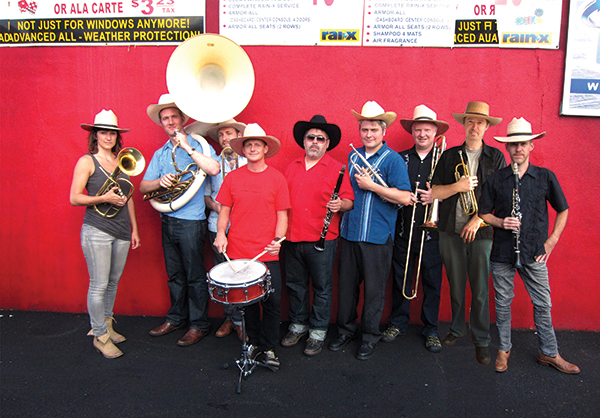
Banda De Los Muertos
“Jacob and I want to dedicate this album to all of the immigrants, like my parents, who came to the United States from Mexico to start a new life, but who held on to their memories and to the music that they loved.” – Oscar Noriega
Oscar Noriega may live in New York, but he’s old school Tucson at heart. Born in California of Mexican immigrant parents, before moving to Tucson when he was eight, the forty-seven year-old Brooklyn resident and Sunnyside High graduate spent a good part of the 1970s playing in Hermanos JOVEL with his four brothers, playing rancheras, boleros, cumbias and other traditional Mexican music all over the Tucson area. Eventually leaving Tucson for California then the east coast, he studied jazz at Berklee in Boston before landing in New York City, where he’s called home for the last 25 years. Noriega has made a living as a jazz musician in NY for most of that time, no mean feat, playing alto sax, clarinet and drums with the likes of Lee Konitz, Paul Motian, Dewy Redman and Tim Berne.
Well, you can take the musician out of Tucson, but you can’t take Tucson out of the musician. Somewhere along the way Noriega rekindled his interest in traditional Mexican music, especially the brass driven genre banda, which has also been popular in the barrios of Los Angeles and Southern California in recent years. Along with fellow jazz/world music traveller Jacob Garchik (they played together in the Balkan hybrid combo Slavic Soul Party) they founded Banda De Los Muertos five years ago to play at a Dia de los Muertos celebration in Brooklyn. They have been playing ever since to crowds equal parts New York hipsters and Mexican and other Latino immigrants. They have just released their debut CD on New York’s Barbés Records, home to many fine internationally-flavored releases, and, incidentally, the new label for Tucson’s own XIXA, formerly known as Chicha Dust. The CD has gained considerable traction in the national media, including a review on NPR’s “Fresh Air.” One of their recent live shows was warmly reviewed in the New York Times. They are putting a national spotlight on banda in much the same way that the game-changing Barbés release Roots of Chicha did for the Peruvian psychedelic cumbia hybrid chicha several years earlier.
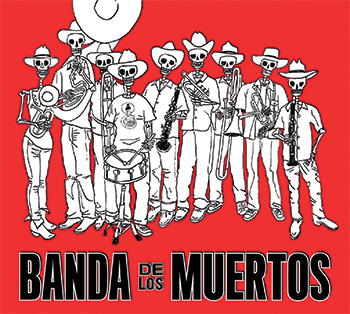
Banda album cover illustrated by Valerie Trucchia.
Banda De Los Muertos’ self-titled CD sticks fairly close to traditional banda, with barely a hint of modernity around the edges. The rest of the band is rounded out with several other NY-based jazz players, and topped off with the occasional vocals of Mireya Ramos, of New York’s popular all female mariachi ensemble Mariachi Flor de Toloache. The album mixes up traditional banda and other Mexican tunes (including “Tragos Amargos,” a hit for Ramon Ayala) with a cover of Marty Robbins’ hit “El Paso” and a lovely cover of “Te Quiero Tanto,” a song written and originally sung by Noriega’s grandmother Susana Dominguez Ruiz. Perhaps best of all is the rousing the lead-off track, “Cumbia de Jacobo,” a slippery, party-ready shuffle written by Noriega and Garchik. And their first video, for “El Paso,” features classic footage of the brothers and la familia in Tucson in the 70s.
Noriega’s life in Tucson was saturated with music, both with Hermanos JOVEL and in the culture at large. “From the 7th grade till my senior year of high school I was gigging almost every weekend. We played a lot of Mexican parties and weddings, quinceañeras, we played at the El Casino Ballroom a bunch. We did a lot of church functions, and you know Arizona, everybody had parties in their backyard. We also did gigs in Bisbee, Wilcox, Green Valley, wherever they called us from.”
“My father always had Mexican music going, constantly, a lot of banda music, a lot of norteña. He had the house fully wired, there was speakers everywhere, outside, inside, every room had it. And we went to church every week (at Santa Monica), and there was always a mariachi band playing there every week. There was always some kind of music going on.”
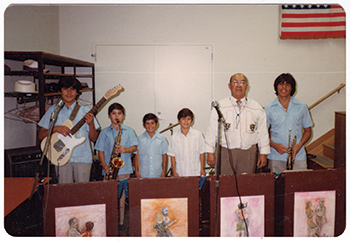
Hermanos JOVEL (Victor with guitar, Oscar with saxophone, Indio, Elias, our teacher Uchi Hernandez and Jaime with trumpet) playing a gig at the senior citizen center down town Tucson in the early 80’.
What did playing music at such a young age bring to his career as a musician, especially one in the high stakes game of jazz, with its improvisation? “I think it was good just have experience at a young age. Nothing beats performance, in front of people…it gave me confidence, to improvise. In the end I realized that it’s all the same, you just use your ears and play, and try and expand on the song your performing.”
“We played in front of the Trump building a month ago, after the debate. Where I grew up, it was 45 kilometers from the Mexican border, and a lot of Mexican’s would pass on our street asking for water or food, and we would feed them. As a kid…it took me awhile to realize what was happening. When I left Tucson and moved to the east coast, I didn’t really think about it for awhile, until I came back as an adult and realized what it was. And then playing this music brought me back to remembering what was going on at that time and seeing a lot of what was happening to immigrants that were coming to Tucson, seeing how they were treated. What I loved when I was a kid, and playing for all kinds of people…it was always a festive moment, some kind of happiness was going on there, amongst all the chaos going on.”
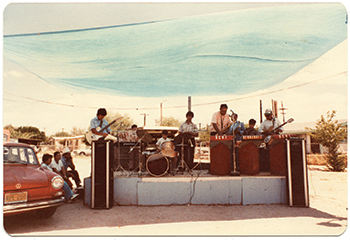
A party in the south side of Tucson
With offers coming in to play around the country, it seems inevitable that Banda De Los Muertos will eventually make it to Tucson, which would be only fitting. Noriega says “Ironically, when I was high school, I was like ‘I’m never playing this music again, I just want to play jazz or classical music.’ I’ve come full circle to this music again.”
Tucson’s Inaugural 10 West Festival
 An Innovative Way to Drive Economic Development
An Innovative Way to Drive Economic Development
This month, Tucson creators and entrepreneurs come together for the first ever “10West Festival,” a new and innovative approach to fostering a creative and technological environment in Tucson, with the goal of attracting and retaining talent in Southern Arizona.
To learn more about the festival, Zócalo reached out to Greg Teesdale, Executive Director of 10West. In addition to 10West, Greg delivers curriculum to Startup Tucson accelerator and incubator programs as well as provides senior executive leadership to Startup Tucson. He is a member of the Desert Angels and also the Chief Financial Officer of Tempronics, a local growth stage technology company and a Desert Angels portfolio company.
Z: Please tell us about 10West and what you hope to accomplish during this inaugural event.
GT: Central to our mission at Startup Tucson is driving economic development in southern Arizona by fostering the entrepreneurial ecosystem, creating an environment where technologist and innovators can develop their ideas into real businesses and hold events, like 10West, that reflect these goals.
We describe 10West as the 20-40 year old demographic, the streetcar line geographic and the October 18-24 chronologic. This is the foundation year for an event that will ultimately be identified with Tucson and Southern Arizona on an international level.
The biggest challenge in this inaugural year has been gaining widespread recognition and endorsement of the event. The most important measure of success this year will be in attendance and we’re shooting a combined 5,000 – 10,000 people across all the events. Thinking long-term the true test will be how well we attract and retain talent in Southern Arizona.
Z: Can you describe the three organizational tracks the festival is focused on, why they were identified as such, and their importance to our region?
GT: 10West has been shaped to address the long-term goal of attracting and retaining talent in southern Arizona. When one believes that Southern Arizona is the place to achieve their desired life-work balance they will build careers and chase their entrepreneurial dreams here. The 10West technology track features workshops, panels and talks on cutting edge topics like 3D printing, virtual reality and the internet of things while the entrepreneurship track has sessions on building a company, access to capital and the many skills essential to every entrepreneurs’ toolbox. The 10West creative track addresses the live part of live-work with network mixers, music and entertainment as well as programming on the business of entertainment. Combined, these events are intended to attract the demographic that will be deciding their future.
Z: How is Tucson or Southern Arizona different from other regions in terms of our innovative and creative environment? What sets us apart?
GT: Southern Arizona has a number of features – a great university with a technology transfer agenda, a vibrant arts district, formation capital and, of course, the weather – that are important factors in attracting and retaining businesses and talent. The business community has to continue to get better at leveraging these features. The one thing that is unique to southern Arizona is the proximity to Mexico. There are great cross-border things happening and I’m seeing a noticeable up-tick in those activities. You’ll hear this theme echoed in the words and initiatives being promoted by Ricardo Pineda at the Mexican Consulate, Sandra Watson at the Arizona Commerce Authority and Denny Minano at Sun Corridor. It is no coincidence that these organizations are active supporters of 10West.
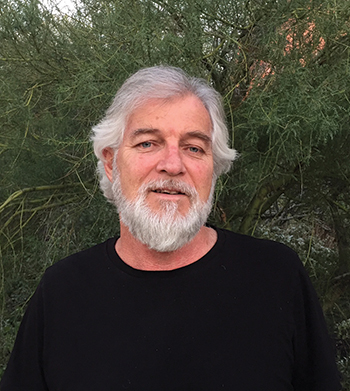
Greg Teesdale, 10West
Z: What is it going to take to jumpstart a Tucson economic boon, centered around technology, innovation, and creativity?
GT: A common saying in the national startup scene is that you have to take a twenty-year view and every day we start a new twenty years. While there’s great appeal to the idea of a magic bullet that will “jump start” economic development, success or more likely defined by a long list of small wins. We’re seeing those kind of small wins every day. And it takes the cooperation and participation of the collective stakeholders to keep these wins coming.
Z: How did 10West come about? What was the inspiration behind the creation of this festival?
GT: There are two key events in 10West that are the foundation of 10West. IdeaFunding was founded 19 years ago by Larry Hecker, a local attorney and active member of the business community. The Desert Angels, the local angel investor group, is the 3rd most active angel group in the US and the host of the Southwest Regional Angel Capital Conference. The organizing groups around these events felt there was an opportunity to leverage these events into something bigger and broader.
Last February we kicked this thing off at the Startup Tucson offices. We didn’t have a name, a mission, a logo or a website. The themes (technology, entrepreneurship, creative class) and definitions (demographics, geographic, chronologic) were all decided early on and we went from there.
Z: What are some of the highlights of the event?
GT: If we’ve done this right the highlight of the event will be different for everybody. It’s important to us that 10West be viewed in its entirety and not defined by any individual series of events. Even the events that get the best attendance may not be the most important in the long run. Having said that, the 19th year of IdeaFunding has to stand out. Larry Hecker’s vision continues to inspire. The technology and entrepreneur workshops and panels are at the heart of the mission. The Connected Communities Forum on Monday represents the confluence of technology and public infrastructure and will give us insights into how the Tucson of the future will look and feel.
Z: How is 10West being funded?
GT: 10West is being funded by a variety of financial sponsors from the community including the Arizona Commerce Authority, Research Corporation for Science Advancement, New York Life, the Desert Angels and many others. In addition we are receiving in-kind sponsorships from our partner organizations such as Hotel Congress, Rialto Theatre, Tucson Museum of Art, Connect Coworking and many others. Finally we have a number of media sponsors including this magazine, Clear Channel Outdoors, Arizona Daily Star, AZ Bilingual and many others.
Z: What are your plans for subsequent festivals?
GT: During 2015 we have answered the question “What is 10West?” We intend to build on name recognition and the goodwill of all of those involved to grow and broaden our reach. Over time we expect to grow regionally, nationally and internationally. We’ve engaged the Hispanic community and expect those connections to draw attendance from Sonora and points south. There are other legacy October events that may be brought under the 10West umbrella provided they fit the mission of the festival. 10West 2016 is scheduled for October 16-22.
Z: Anything else you would like to add?
GT: There is a lot of support for 10West but, more importantly, there’s even more support for the things that 10West represents.
10West takes place in Downtown Tucson, October 18-24th. For information, including a complete schedule of events, please visit www.10west.co
Songs Stuck on Repeat
It’s a nearly universal human phenomenon, an experience that can be a blessing or a curse; educational or irritating; crazy-cool or enough to drive someone crazy. It happens to over 90 percent of us and scientists still don’t really know why.
This occurrence is the ubiquitous ear worm – a tune that gets stuck in your head. It spins around ad nauseam, and maybe fades away when more complicated, cerebral tasks come along only to pop up again later when your brain isn’t otherwise occupied. Or perhaps when it is otherwise occupied. It really depends on you. One thing The Arizona Ear Worm Project investigators have found is that the ear worm experience is highly personal.
Last month, in an office at the Speech, Language and Hearing Sciences building on the University of Arizona campus, these researchers discussed their project “Musical Cognition, Emotion and Imagery: Understanding the Brain, One Catchy Song at a Time.” The project was funded through the UA’s Confluencenter for Creative Inquiry Faculty Collaboration Grant program.
What was discovered and what remains to be uncovered surprised the interdisciplinary team. They will present their findings in a presentation called “Can’t Get You Out of My Head!” for Confluencenter’s Show & Tell event on Wednesday, Oct. 7.
“One of the main things that happened – (which was) exciting from a scientist’s perspective – is that we got rid of all the easy answers,” said Speech, Language & Hearing Sciences Associate Professor Andrew Lotto. “All the easy answers are not true: that ‘all ear worms look like this, everyone who has an ear worm looks like this.’ One of the things about scientists that oftentimes people don’t understand (is that) easy answers are not that exciting to a scientist. So, as this has gotten more and more complex, it becomes more and more interesting.”

The Arizona Ear Worm Project includes Dan Kruse, an ethnomusicologist and AZPM radio announcer, UA Associate Professor of Music Theory Don Traut, and Speech, Language and Hearing Sciences Professor Andrew Lotto.
photo: Jamie Manser/Confluencenter for Creative Inquiry
Dan Kruse, a radio announcer at Arizona Public Media and an ethnomusicologist, was inspired several years ago to investigate why songs get stuck in people’s heads after hearing a National Public Radio story on music psychologist Victoria Williamson, “who, of all things, was doing research into what starts ear worms,” said Kruse. “And I thought, ‘that’s so interesting, that somebody would actually study such a thing because I’ve experienced this my whole life.’”
Kruse recruited Lotto and Associate Professor of Music Theory Don Traut to join the team. “Don had done some really interesting research about hooks in pop music that lined up so beautifully with this,” Kruse shared.
When Lotto, Kruse and Traut – all music lovers – initially began batting around ideas and hypotheses, they collectively realized that their combined knowledge and perspectives would work together perfectly. Kruse was responsible for the interviews and the human touch, Traut approached it from a music theory perspective, and Lotto from the hearing sciences angle.
Once they started drilling into the meat of the matter, ideas about common harmonic patterns leading to ear worms and common songs recurring among the research subjects were tossed out due to lack of evidence. “Out of 150 to 200 ear worms (we studied), there were less than half a dozen that were repeat songs. It’s not like everybody has the same four to five songs stuck in their head,” Traut said. “It’s really a very personal thing. I thought that was significant. I thought there would be more uniformity.”
While the individuality of the ear worm occurrence was notable, Kruse said there were also cases when the song-stuck-on-repeat became a collective experience among partners, friends or coworkers. “Sometimes unspoken, they just notice they will hum something out loud and notice later that someone has the same thing going on,” Kruse said.
Kruse proposed that future research could “go ethnomusicologically – what are the qualities of music that people listen to? Are there certain things in music that people attach to? Are there music universals?”
“Again, the ear worm itself is a way of getting into the questions that we care about,” said Lotto. “The ear worm is one of these experiences that nearly everyone has related to music and it lets us start getting at why this sound (music) is so important across cultures for every single person, because it is a complex sound – it’s like a speech sound, an animal call – these are all complex structures.
“Why music and why not these other sounds?” Lotto queried. “There’s nothing really special (from a hearing science perspective) about the sound of music, yet our experience of it is very special.”
Find more information on The Arizona Ear Worm Project at AZEarWorm.org. The presentation “Can’t Get You Out of My Head” is on Wednesday, Oct. 7 for Show & Tell at Playground, 278 E. Congress St. The free event starts at 6 p.m. Visit Confluencenter.org for details or call 621-0599.
Ambassador of Rock
 Hannah Levin, new host of ‘The Home Stretch’ weekdays from 3-6pm on KXCI 91.3 FM, is a long-time music critic and journalist, graduate of Seattle’s legendary KEXP, and the real-life inspiration for Toni Collette’s character in the indie film Lucky Them. Hannah talked to Zócalo about her recent move to Tucson, her thoughts on gentrification and urban renewal, and her hopes and plans for our local independent music scene.
Hannah Levin, new host of ‘The Home Stretch’ weekdays from 3-6pm on KXCI 91.3 FM, is a long-time music critic and journalist, graduate of Seattle’s legendary KEXP, and the real-life inspiration for Toni Collette’s character in the indie film Lucky Them. Hannah talked to Zócalo about her recent move to Tucson, her thoughts on gentrification and urban renewal, and her hopes and plans for our local independent music scene.
Z: You moved here from Seattle in October of 2014. How did that come about?
HL: I originally considered moving to Tucson for a job with a non-profit foundation that was based in Seattle but had offices here. Then I heard about KXCI and that definitely got my wheels turning. I started listening to it online, found (then Program Director) Cathy Rivers’ contact info, set up a meeting with her and as soon as I walked into the room was like “oh, hello.” She was obviously my kind of woman — an intelligent, strong, tattooed, feminist rocker lady. Then when the non-profit foundation I worked for decided to eliminate that position at the exact same time that Cathy was made General Manager, those things all kinda lined up. I literally texted Cathy the day I found out about my job and she’s like, guess what, I’m Interim General Manager and I totally need your help. It was — not to sound hokey — meant to be. And moving here was the best decision I’ve made in my adult life.
I felt like I stumbled on a big secret when I got here. I just couldn’t believe how amazing the music community was, how amazing the feminist community — the women in this city are particularly impressive to me. And Tucson’s just cool — I don’t think Tucson even knows how cool it is.
Z: Are there similarities between the Seattle you loved and the Tucson you are discovering now?
HL: A really strong, supportive feminist creative community was a huge benchmark of what made Seattle exciting in the early 90s. There are so many things (here in Tucson) that remind me of how I felt about Seattle in the early 90s… Then having my Seattle eroded — and in the last couple of years literally ripped out of the hands of the people who made it happen — if I can help that not happen here, then I can think of nothing better to put my time into.
I lived thru Seattle’s dramatic transformation, and had my heart broken into nine thousand pieces. That was really transformative in a negative way, and I want to take that experience and turn it into a positive and be involved with preventing that here. Because if I came here and saw all of the cool potential, other people are going to figure that out, too. And once that wave of gentrification — on the scale of a San Francisco or an Austin — once it really gets momentum, you can’t stop it. Right now, there’s still some time to think about it, start a dialogue about it, and do whatever we can. That’s hugely important to me.
Z: And what does that look like to you? How can you make a difference?
HL: There’s this unfortunate resigned sense of inevitablity that I see in a lot of my peers. “Gentrification is happening everywhere, it’s just the way it is. The artists come in and make it cool and then it gets taken over.” I’m tired of hearing that. Let’s think about it and find another way. Seattle, because of what happened in the grunge years and the subsequent media invasion and hysteria, and what happened to that community, particularly in the years after Kurt (Cobain)’s death, made a lot of people feel really defeatist. And we have to figure out how not to feel powerless. The best thing I can think to do is be proactive, recognizing opportunities to do something positive, whether it’s protecting something that exists, or nurturing a new business idea that meets a need the community has. Like the idea of locally-owned drugstore downtown; if that’s a real need, as it appears to be, how can we as a community get that going with a local business owner before a Walgreen’s or CVS comes along?
The best way I know how to do that is gather people together that want to talk about it in a way that is focused, and not just bitchin’ at the bar about it, know what I mean? Not letting stuff just happen. Complaining and grief about loss is perfectly acceptable. But not throwing up your hands and saying “I can’t make a difference.” Individuals banding together with common causes, they can make a difference. I really believe that. It might sound wildly optimistic or naïve — but I’m 44 years old so I don’t think I’m naïve.
Z: Was there a particular moment in Seattle, a particular loss, that really sticks with you?
HL: The Crocodile (Café — listed as one of the top 10 music clubs in Rolling Stone, in 2013). The Crocodile closing was a huge, huge, huge thing. The night I heard about that I went home and I told my boyfriend, “we are moving to Austin.” Which is funny because Austin now is just as screwed up as Seattle. You are talking about the place that was the de facto wake place when Kurt died. It’s where so many incredibly important shows (like Nirvana, Pearl Jam, Alice in Chains, Death Cab for Cutie, Sleater-Kinney, Built to Spill, etc.) happened. It was the anchor of the Seattle music community. It was home base.
We also lost a series of rehearsal spaces, which, at the risk of stating the obvious, is extremely important to incubating new bands in a creative community. People need to have an affordable place to rehearse. We saw bands breaking up because they had nowhere to practice. Housing was so expensive that there wasn’t even the cheap punk-rock house with the basement you can practice in. We didn’t even have that and then when rehearsal spaces go away… that’s a tourniquet on creativity.
Z: One of the things that engaged newcomers to a community can provide is the insight that something that clearly ought to be here is glaringly missing. What would you like to see in Tucson that you haven’t discovered yet?
HL: A really sexy BBQ place (laugh). For grown-ups. That’s also a live music venue. I really hope somebody does that. Something that feels like a set-piece from the movie Deathproof. That would be good.
I’m still discovering things, obviously. I keep waiting to stumble on some rad Latino hip-hop collective. Maybe it’s out there somewhere. I hope so. Hip-hop is a storytelling genre, and the hip-hop community in Seattle, even though it was not particularly large, was the kind of nucleus that really impacted the alt-country community, the rock community… it created a good ripple effect for all of the other artists surrounding it.
Z: You’re coming from one of the most influential independent radio stations in the country (Seattle’s KEXP); how does that inform your work now at KXCI?
HL: I hosted a show called “Audio Oasis” on KEXP for a long time, a local music show, and that was all built upon telling the history of Seattle music and breaking the newest talent at the same time. That was my formative experience in radio, to make sure that we were playing the iconic artists who helped build Seattle into what it became, but also then going out to the clubs and finding the new, undiscovered stuff, listening to all of the damned demos… that’s how I found The Head and The Heart. They were a demo in my box. I played it and thirty seconds in I called my producer and was like, “book them — now!” We got them in the studio and two weeks after that, (they blew up). I was the first person to play them on the radio.
Based on what Cathy is envisioning, and what I certainly hope to see, we want to continue to program KXCI in ways that appeal to people who have been with the station for a long time, and honor the things that have made the station what it is. At the same time, and this is tricky, we have to start pulling young people in and getting them involved, making the station a more accurate representation of the contemporary cultural landscape of Tucson.
Z: A lot of DJ’s are former performers. But you make no bones about the fact that performing is not your thing.
HL: Putting things together and showcasing them in a lovely light is something I’ve always wanted to do. The music we are listening to now in the background is a draft of tomorrow’s set. That’s how dorky I am. So I surf around a lot of genres and try and interlink things in a thoughtful manner and not jar the listener. Because if you are trying to push the envelope a little bit — a hip-hop thing, or some of my more metal-oriented songs — you don’t open people’s minds to new songs by giving them sonic whiplash. You do it gracefully. And I want the punk rock kid hanging out down at Che’s to like it just as much as my mom does listening online back in Tacoma.
Z: And you don’t appear to spend a lot of time on your airbreaks…
HL: I will interject if someone is coming to town, or there’s an interestingpiece of history, or if I picked a song because I saw it in a movie recently. But you are never gonna hear me babble on because it’s not about me — it’s about the music and the listener.
Z: Where do you find inspiration?
HL: I have a running note-pad thing on my phone where if I think of a song or an artist I’ll jot down a note about it. Because when you program 15 hours of music a week, you have to constantly be thinking about it or else you are gonna get stale. And I get a great deal out of social media, too, because I’ve been around for a while and know a lot of interesting music journalists, and crate-digging record collectors… Today for instance my friend Peter, who lives in upstate New York and was a DJ for many years and also in a great band called the Chrome Cranks, posted this Led Zeppelin song we’re listening to, ”Wearing and Tearing,” and that he’d heard a story that Robert Plant and Jimmy Page wrote this song late one night
after seeing The Damned. I think that’s really interesting! And so I immediately said thanks, Peter — I’m totally stealing that for my show on Monday!
Z: You’ve mentioned that living in Guatemala was a life-changing experience for you. How so?
HL: It recalibrated my values in the way that travel does. It was humbling to be somewhere there was abject poverty, and violence, (all) amidst great beauty — if I was President, everybody would have to travel in their formative years to somewhere that made them uncomfortable.
I also had a big experience with music there, talking to this kid who really loved Metallica. I of course being an old-school Metallica fan, and being twenty-four and full of myself, I’m lecturing this 11-year old kid on how their old stuff is really where’s it at, and he’s like “I really like ‘Enter Sandman.” And I realize, I’m an asshole, that kid should like whatever he likes. I’m gonna shut up right now because anyone getting joy out of music, I support that. And as a result of that experience I have zero patience for music snobs.
Z: The future of KXCI. What do you see? What do you want to see?
HL: Significantly increasing our live in-studios with touring and local bands of all genres. I got very used to being at a station where when touring bands (came) through (Seattle) they wanted to play at KEXP, and I want KXCI to be the same way. I want to be a good ambassador for Tucson in terms of touring musicians. I want them to have a really good experience, sonically and socially, while they are here. I want artists to want to play KXCI because we have such passionate music fans. And the more exciting and stimulating bands come through, the more they inspire local musicians, the more you grow the scene further. That’s the holistic picture of what a local radio station can do. So I have big dreams.
Z: The author William Gibson (Neuromancer, Pattern Recognition, etc.) has this line that’s been haunting me recently: “The future is already present, it’s just not evenly distributed.” Seattle strikes me as a town where the future is more present than Tucson, while here the past might be much more present than the future… Do you see that distinction?
HL: It reminds me of when I was in Amsterdam last year I saw a graffiti — “our future is already haunting us” — which stuck with me a lot. Finding the middle ground, not being so far mired in the past, nor consumed by a future world where any sense of history is annihilated, that’s the challenge right there.
Z: Or the fact that Tucson today reminds you of Seattle in the 90s… Are we really 20 years behind the times? And might that be a good thing?
HL: Well, if you get time travelers like me who come back to help it is (laughs). Just kidding. There’s a reason I have a typewriter and a turntable tattooed on my body. I like cool old stuff. The sheer volume of dive bars and old-man diners here in Tucson makes my heart sing. They were systematically wiped out in Seattle — there’s only a handful left. And anyone reading this might be like “you have no idea, downtown used to be so different…” I totally get that, and I’m not saying that the losses people have experienced around here don’t matter — they absolutely do. But for me, from where I’m coming from, for where I am in my life — this place is heavenly. To see this much history intact, to see all these mid-century buildings, to see independent businesses making cool things happen, it’s like I got a second chance
Tapping the Collective Unconscious
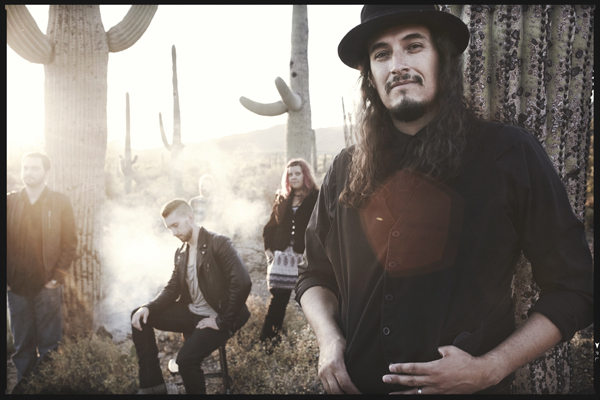
Carlos Arzate and The Kind Souls
© Puspa Lohmeyer Photographer
“He was laying there (in the hospital) and he told me, ‘All the songs are written, we don’t write the songs. We listen and we communicate the songs,’ which is something I’ve always believed.” Singer/songwriter/guitarist Carlos Arzate is speaking with depth and sincerity while relating a conversation he had with dearly departed Tucson musician Cyril Barrett last year, before cancer whisked Barrett’s life from his body.
“I’ve always believed that the melody that came into me or that I thought I was inspired by was already existing, whether it was decades ago or centuries ago,” Arzate shares. “The voice is the first instrument – some would argue the drum – but I think the voice is the first soul instrument that connects, so I was beside myself when he said that.”
It all makes sense. Listening to Got Me Wrong, the first full-length by Carlos Arzate and The Kind Souls, it feels evident that Arzate is culling from the collective unconscious. While several of his songs are deeply personal, they touch emotions we all experience; these cuts connect us to the frustration, sadness and anger of social injustice, the pain of losing a love one and the resoluteness of changing one’s outlook on life.
The 11 tracks are a powerful convergence of soul, rock, blues and folk, featuring an absolutely stellar line-up of Tucson’s finest musicians. Carlos is measured, but clearly beyond the moon when talking about the talent on this disk. While we listen to the album and discuss the nuances of each piece, he points out who is doing what and where and is touched by the creative efforts of The Kind Souls.
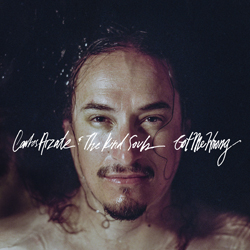
photo: Taylor Noel Photography
“What’s been great about this is being able to work with the musicians I’ve wanted to work with in Tucson – I asked them (to collaborate) and they said yes.” It is easy to get behind a project that spears the dominant paradigm, humanizes political footballs and reminds us that we aren’t alone in our struggles.
Carlos’ friend and consistent musical colleague Keli Carpenter contributes her honeyed vox to six of the cuts, Katherine Byrnes sings on three tracks and Crystal Stark vocally joins those two on one tune. The other amazing performers include: Nadim Shehab (drums), Aaron Hultstrand (electric guitar), Collin Shook (piano, organ, vibraphone), Brian Lopez (guitar, vocals), Gabriel Sullivan (guitar, vocals), Salvador Duran (vocals), Efren Cruz Chavez (congas, guiro), Thoger Lund (cello), Ryan Green (acoustic guitar), and Ryan Alfred (bass, synthesizers, guitars, plus production and mixing.)
“Ryan Alfred was instrumental in encouraging the development of my songwriting and growth as a performer,” Arzate elucidates. “His talents and direction are stamped on the record as a performer and a producer. He has a knack of knowing exactly what my song calls for and is all ears when it comes to allowing me to flesh out my ideas against his gifted musical mind. His professionalism and attention to detail is a great counter balance to my raw inspired musical creations.”
There’s something to be said for finessing rough edges. The clean, yet authentic production values lure the listener into these literary sketches. Tales of life and death, the financial meltdown, the migrant trail, loved ones speaking from beyond the grave, lovers leaving us, the evolution of personal narratives, songs of escapism that know the truth but don’t want to deal anymore. Straightforward, deep messages without being heavy handed. Songs that viscerally touch and connect us, heart-wrenching and gut punching at times – but in a good way. Hopefully in a way that will inspire and mobilize social change.
An absolutely gorgeous album well worth adding to one’s collection.
“Got Me Wrong” is set for release on Sept. 1 on iTunes. The band is playing on July 31 at Scottsdale Center for the Performing Arts. Fall tour dates include: Sept. 3, Hermosillo; Sept. 4, Phoenix; Sept. 5, Bisbee; Sept. 6, Tucson; Sept. 18, Prescott; Sept. 19, Flagstaff; Sept. 20, Tucson. Oct. 17, Flycatcher Tucson, $10. Times, cover charges, locations and more will be available at CarlosArzate.com.
Mercado San Agustin Spring Bazaar

Sat and Sun May 2nd and 3rd
The Annual Mercado San Agustin Spring Bazaar returns in May getting shoppers into the spirit of celebrating family and friends, and having some fun finding gifts for Graduates and Mother’s Day.
In conjunction with Spring Bazaar, there will be a special ‘Farm to Table Brunch’ event with covered outdoor seating in the beautiful old world courtyard for patrons to enjoy. Sample food, coffee and artisan cocktails while you shop.
The mercado has handpicked 50+ local shops, makers and artisans to offer shoppers an event where they can buy a variety of unique and one-of-a-kind gifts during this weekend-long event. The Mercado San Agustin Spring Bazaar is dedicated to sharing bright and emerging entrepreneurs and businesses from within the region. Included in this juried pool of very talented makers who will be onsite during Spring Bazaar will be a group of high school students from the Western Institute of Learning Development, a local public school, who have created and developed a line of bags that they have made in their journey to discover the power of entrepreneurism and the opportunity it brings.
Some of the Artisans and Shops attending include:
Woolies and Buster and Boo, Lila Clare Jewelry, Val and Vanessa Galloway, Guatemala Acupuncture Project, Razzle Dazzle, Eco Grow, Revolutio, Collected Artifacts, Anita’s Crafters, Elaine Isner, Jacqueline Knits, Linda Cato, W.I.L.D. High School, Creative Kismet, Desert Vintage, Willies Fort, Tu Kaets Pottery Studio, Avenue, Tin & Teak, Becky Zimmerman alongside our permanent stores like MAST, Transit Cycle and Blu.
The Spring Bazaar takes place at Mercado San Agustin, 100 Avenida del Convento, Tucson, on May 2 and 3 (Friday & Saturday 10am-6pm). For more information, vist www.mercadosanagustin.com

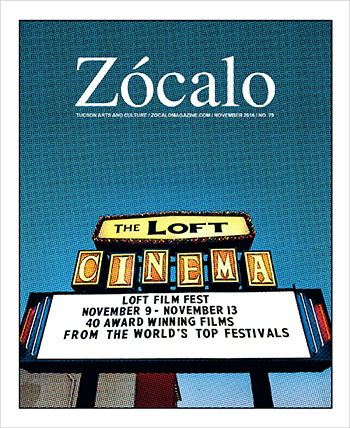
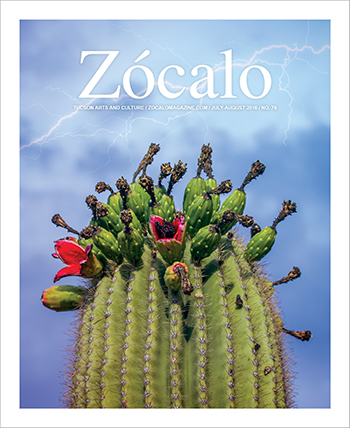
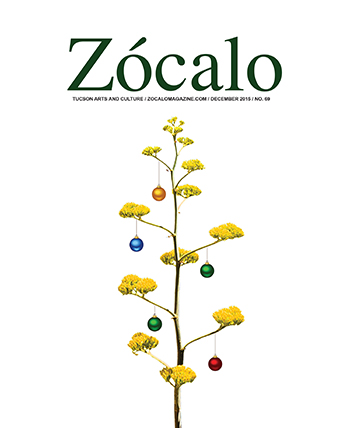




Also find us on...